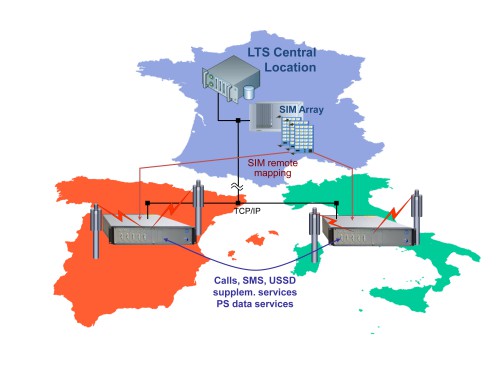IREG test automation: remote UEs, central SIMs

In the late 90s, it seemed to be a sort of magic to make a mobile phone ringing without typing the number of the recipient explicitly on the keypad of another phone. At the GSM World exhibition in Cannes (today’s Mobile World Congress, which has been moved to Barcelona), an exhibitor even had a magician at his booth to impress visitors with this kind of trick. “It is not illusion, it is technology” said the magician at the end of his show.
Central test lab – probes with UEs in the live network
What could fascinate visitors to a fair about 15 years ago was nothing else then a computer controlled modem making a call. This is the principle, up on which Qosmotec’s functional test system LTS-F is based. A compact computer board controls up to 8 modems. All this is put into a 19 inch chassis and such a test probe can be placed anywhere, where power supply and an internet connection is available and can execute test cases in live networks without the presence of an operator. The remote probe, or even a whole bunch of them, can be controlled from a computer at a central location and the executed steps, taken measurements and achieved results are logged, gathered and analyzed there. “This is extremely helpful for executing international roaming tests, much better than sending staff in all kinds of countries, where tests shall be executed”, explains Qosmotec’s technical director Axel Voigt. “Just the UE chassis needs to be shipped and plugged in and will automatically get into contact with the central control unit.”
Industrial modems instead of commercial handsets
Axel Voigt and his team have vastly extended the features and capabilities of the remote probes over the last years. “The reason, why we use industrial modems inside the probes instead of commercially available handsets is not merely a matter of compactness and construction, it is because of the test results that we want to provide our customers. These modems are made for remote control purposes and allow to extract information that the user would typically see on the display of his phone. This approach is much more effective than using complex techniques like image or voice recognition.” Modems for all kinds of mobile technology are available, covering all relevant frequency bands for 3G and 4G in Europe as well as America and Asia. Also American CDMA and EV-DO standard are supported.

The SIM array provides the platform for international roaming tests. Up to 13 SIM boards can be plugged into one rack.
No simulation, no modification, just mapping of SIM cards
It makes the remote tests even more convenient that the modems do not necessarily need to be equipped with SIM cards before shipping the remote unit. All needed SIM cards can be kept together in a SIM array with the LTS central control unit and can be mapped via software before test starts. This reduces planning effort for test execution as well as the amount of modem equipment needed drastically, because the same mobile can work sequentially in various operators’ networks without any physical interaction. This is the basis for the full automation of IREG test cases.

LTS-F enables testers to run remote controlled tests with UE test probes spread over several countries
Though it is just a very simple concept of spatial separation from the hardware components mobile and SIM cards, it is sometimes really difficult to explain, what it does. “Very often, people think that very mysterious things happen when transmitting the SIM card information to the modem”, tells Axel Voigt about serious misinterpretations that he has already been confronted with. But there is no simulation of a SIM card, nor is there any modification of the information on the SIM cards. A picture that we really like is the representation of a SIM card in form of a butterfly, symbolizing that the SIM is flying from one location to another. The only prerequisite is a stable internet connection between central unit and remote probe.
But there is no simulation of a SIM card, nor is there any modification of the information on the SIM cards. A picture that we really like is the representation of a SIM card in form of a butterfly, symbolizing that the SIM is flying from one location to another. The only prerequisite is a stable internet connection between central unit and remote probe.
IREG test automation is one of the most important applications of LTS-F. Qosmotec can provide ready-to-use test sets for IR24, 35 and 60 specifications. But LTS-F is also very intensively used by Virtual Network Enablers and Operators (MVNEs and MVNOs). They use it for functional tests in those countries, where they are offering their services and just need to send a probe there, while they can execute all tests from their respective headquarters.



